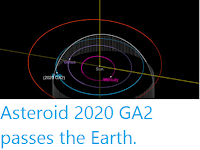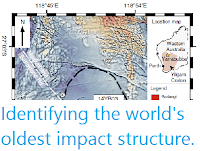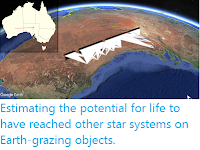Asteroid 2020 GN2 passed by the Earth at a distance of about 1 229 000
km (3.20 times the average distance between the Earth and the Moon,
or 0.82% of the distance between the Earth and the Sun), slightly after 9.00 am
GMT on Thursday 16 April 2020. There was no danger of
the asteroid hitting us, though were it to do so it would not have
presented a significant threat. 2020 GN2 has an estimated
equivalent
diameter of 14-45 m (i.e. it is estimated that a spherical object
with
the same volume would be 14-45 m in diameter), and an object of this
size
would be expected to explode in
an airburst (an explosion caused by superheating from friction with the
Earth's atmosphere, which is greater than that caused by simply
falling, due to the orbital momentum of the asteroid) in the atmosphere
between 28 and 10 km above the ground, with only fragmentary material
reaching the Earth's surface.
300 second image of 2020 GN2 taken with the Elena Planetwave 17" Telescope at Ceccano
in Italy on 16 April 2020. The asteroid is the small point at the
centre of the image, indicated by the white arrow, the longer lines are stars, their elongation being
caused by the telescope tracking the asteroid over the length of the
exposure. Gianluca Masi/Virtual Telescope.
2020 GN2 was discovered on 13 April 2020 (three days before its closest approach to the Earth) by the University of Arizona's Catalina Sky Survey,
which is located in the Catalina Mountains north of Tucson. The
designation 2020 GN2 implies that it was the 61st asteroid (object N2 -
in numbering asteroids the letters A-Y, excluding I, are assigned
numbers from 1 to 24, with a number added to the end each time the
alphabet is ended so that A = 1, A1 = 25, A2 = 49, etc., which means that N2 implies the 61st asteroid (N2 = (24 x 2) + 13 = 61) discovered in the first half of April 2020 (period 2020 G).
2020 GN2
has a 595 day (1.63 year) orbital period and an eccentric orbit
tilted at an angle of 6.07° to the plane of the Solar System, which
takes it from 0.87 AU from the Sun (i.e. 87% of the average distance
at
which the Earth orbits the Sun) to 1.90 AU from the Sun (i.e. 190% of
the
average distance at which the Earth orbits the Sun, and further from from the Sun than the planet Mars). It is therefore
classed as an
Apollo Group Asteroid (an asteroid that is on average further from the
Sun than the Earth, but which does get closer). This means that close
encounters between the asteroid and Earth are fairly common, with thelast having happened in September 2015 next predicted
in September 2028. 2020 GN" also has occasional close encounters with the planet Mars, with the last having happened in January 1985.
See also...
Follow Sciency Thoughts on Facebook.








